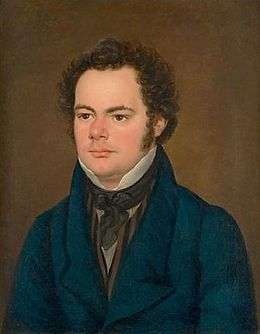Mass No. 6 (Schubert)
| Mass No. 6 | |
|---|---|
| by Franz Schubert | |
|
The Church of the Holy Trinity in Alsergrund, c. 1724, where the mass received its first performance in 1829 | |
| Key | E-flat major |
| Catalogue | D 950 |
| Form | Missa solemnis |
| Composed | 1828 |
| Performed | 1829: Alsergrund Church of the Holy Trinity |
| Movements | 6 |
| Vocal | SATB choir and soloists |
| Instrumental | Orchestra |

Mass No. 6 in E flat major, D 950, is a mass composed by Franz Schubert. It is scored for two tenor soloists, soprano, alto and bass soloists, SATB choir with divisi, 2 oboes, 2 clarinets, 2 bassoons, 2 horns, 2 trumpets, 3 trombones, timpani, violin I and II, viola, cello, and double bass. It was Schubert's final setting of the order of Mass,[1] and is classified as a missa solemnis.[2]
Background
The first date to appear on the score is June 1828, although evidence exists that Schubert had begun to sketch it earlier than this.[3] It was completed by July.[4] It was composed in response to a commission or request from Michael Leitermayer, choirmaster of the Church of the Holy Trinity (Alserkirche) in Alsergrund, Vienna.[3] The mass was not performed until after Schubert's death, with a premiere in the Alserkirche on October 4, 1829. Ferdinand Schubert conducted the premiere, as well as a second performance in the Church of Maria Trost on November 15, 1829.[3][5]
The influence of Beethoven is felt in the mass,[6] particularly in the "ambitious Beethovenian architecture".[7] Schubert had been a torchbearer at Beethoven's funeral, which had been held in the Alserkirche.[3] References to Bach's fugues are present in the Gloria and Agnus Dei, as well as Mozart's Requiem and Haydn's Heiligmesse.[8]
This setting and the earlier Mass in A flat major are regarded as Schubert's "late masses".[9] These are distinguished from his four early masses by their "musically interpretive stance to the words";[10] Schubert began to take advantage of an overall maturation in his technical capabilities and knowledge of harmony, coupled with his experience in composing both sacred and secular music, to add further meaning to the standard text. Already known for consistently omitting certain passages from the text, Schubert took even greater freedoms in the late masses, adding and removing text in a bid to "deepen expression or enhance a particular aspect of meaning".[11]
The Schubert scholar Brian Newbould opined that the late masses were the composer's "two finest and most substantial settings",[12] calling the Mass in E-flat "the triumph and swansong of [Schubert's] career (as far as the composition of masses is concerned)".[13] Schubert's biographer Kreissle von Hellborn wrote that the Mass in E-flat "takes rank with the foremost compositions of the kind written at the time".[14]
The late masses may have influenced the composition of Bruckner's Mass in F minor.[15]
Rieter-Biedermann published the first edition of the piano score in 1865, anonymously edited by Johannes Brahms.[16]
Structure
The mass consists of six movements. Performances require approximately an hour.
- "Kyrie" Andante con moto, quasi Allegretto, E-flat major, 3/4
- "Gloria" Allegro moderato e maestoso, B-flat major, common time
- "Domine Deus, Agnus Dei..." Andante con moto, B-flat major, 3/4
- "Quoniam to solus sanctus..." Allegro moderato e maestoso, B-flat major, common time
- "Cum sancto Spiritu..." Moderato, B-flat major, alla breve
- "Credo" Moderato, E-flat major, alla breve
- "Et incarnatus est..." Andante, A-flat major, 12/8
- "Et resurrexit..." Moderato, E-flat major, cut common time
- "Sanctus" Adagio, E-flat major, 12/8
- In a display of "unusual and thoroughly proto-Romantic modulation",[7] the Sanctus opens in E-flat major, moves to B minor, then to G minor, and finally to E-flat minor, all in the space of 8 bars.
- "Osanna in excelsis..." Allegro ma non troppo, E-flat major, 2/4
- "Benedictus" Andante, A-flat major, alla breve
- "Osanna in excelsis..." Allegro ma non troppo, E-flat major, 2/4
- "Agnus Dei" Andante con moto, C minor, 3/4
- "Dona nobis pacem..." Andante, E-flat major, alla breve
- "Agnus Dei..." Andante, E-flat minor, 3/4
- "Dona nobis pacem..." Andantino, E-flat major, alla breve
Notes
- ↑ Newbould 1999, p. 133.
- ↑ Shrock 2009, p. 383.
- 1 2 3 4 Howie 2008, p. 75.
- ↑ Newbould 1999.
- ↑ Von Hellborn 1869, p. 250.
- ↑ Greene 1985, p. 522.
- 1 2 "Mass No.5 in Ab, D.678". Classical Archives. Retrieved 20 March 2013.
- ↑ Newbould 1999, pp. 286–288.
- ↑ Rushton 2002, p. 155.
- ↑ Gibbs 1997, p. 220.
- ↑ Gibbs 1997, p. 222.
- ↑ Newbould 1999, p. 167.
- ↑ Newbould 1999, p. 270.
- ↑ Von Hellborn 1869, p. 234.
- ↑ Hawkshaw 2013.
- ↑ Avins 1997, p. 280.
References
- Shrock, Dennis (2009). Choral Repertoire. ISBN 9780199716623.
- Black, Leo (2003). Franz Schubert: Music and Belief. ISBN 9781843831358.
- Howie, Crawford (2008). "Small is beautiful: Schubert's smaller sacred works". In Reul, Barbara M.; Bodley, Lorraine Byrne. The Unknown Schubert. ISBN 9780754661924.
- Von Hellborn, Heinrich Kreissele (1869). The Life of Franz Schubert. 2. Translated by Arthur Duke Coleridge.
- Gibbs, Christopher H. (1997). The Cambridge Companion to Schubert. Cambridge Companions to Music. ISBN 9780521484244.
- Greene, David Mason (1985). Biographical Encyclopedia of Composers. ISBN 9780385142786.
- Newbould, Brian (1999). Schubert: The Music and the Man. ISBN 9780520219571.
- Hawkshaw, Paul (2013). "Anton Bruckner and the Austrian Choral Tradition". In Di Grazia, Donna M. Nineteenth-Century Choral Music. ISBN 9781136294099.
- Avins, Styra, ed. (1997). Johannes Brahms: Life and Letters. ISBN 9780199247738.
- Rushton, Julian (2002). "Music and the poetic". In Samson, Jim. The Cambridge History of Nineteenth-Century Music. Cambridge University Press. ISBN 978-0-521-59017-4.
External links
- Mass No.6, D.950: Scores at the International Music Score Library Project
- Free scores of Mass No. 6 in E flat major, D950 in the Choral Public Domain Library (ChoralWiki)